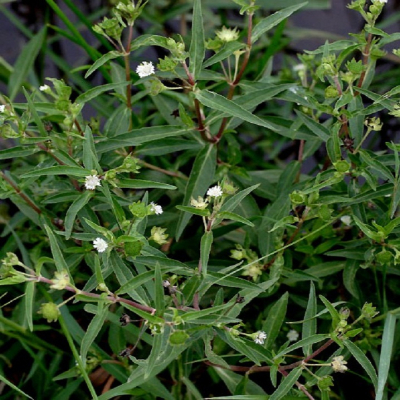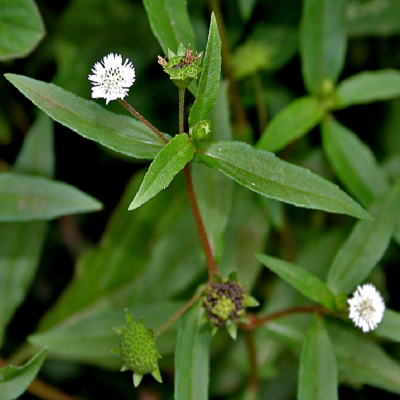Eclipta prostrata (L.) L.
Synonyms : Eclipta alba Hassk.
Family : Asteraceae
Group : 2. Dasapushpam, Anti-dandruff/Hair growth promoters
Parts Used : Whole plant
Vernacular Names :-
| English | : | Trailing eclipta |
| Malayalam | : | Kayyonni, Kayyunni |
| Hindi | : | Bhamgra |
| Sanskrit | : | Bhringarajah/Tekarajuah |
| Bengali | : | Kesraj |
| Gujarathi | : | Kadim-el-bint |
| Kannada | : | Kaddigagarugu |
| Tamil | : | Kayyantukara |
| Telungu | : | Guntagaligageran |
Distribution and habitat: This plant is widely distributed in the warm humid tropics having plenty of rainfall. It grows commonly in moist places as a weed all over plains of India.
Botany: It is an annual, erect or prostrate herb, 30-60 cm high often rooting at nodes.
- Leaves: Opposite, very variable, sessile, narrowly lanceolate, toothed or nearly entire with hairs on both surfaces.
- Flowers: White in heads, pappus of 2-5 minute teeth. Floral heads are 6-8 mm in diameter and solitary. Involucral bracts leaf-like, outer large.
- Fruit: An achene, compressed and narrowly winged.
Properties: The plant is anticatarrhal, febrifuge, antidontalgic, absorbent, antihepatic, CVS active, nematicidal, ovicidal and spasmolytic in activity.
Chemical constituents:
- The leaves contain stigmasterol, a-terthienyl-methanol, wedelolactone, dismethylwedelolactone and its 7-O-glucoside.
- The roots give hentriacontanol and heptacosanol. The roots contain polyacetylene substituted thiophenes.
- The aerial part is reported to contain a phytosterol, b-amyrin in the n-hexane extract and luteolin-7-O-glucoside, b-glucoside of phytosterol, a glucoside of a triterpenic acid and wedelolactone in polar solvent extract. The polypeptides isolated from the plant yield cystine, glutamic acid, phenyl alanine, tyrosine and methionine on hydrolysis. Nicotine and nicotinic acid are reported to occur in this plant.
Uses:
- Eclipta is one of the ten auspicious herbs that constitute the group dasapuspam which is considered to destroy the causative factors of all unhealthy and unpleasant features and bestow good health and prosperity. The members of this group cure wounds and ulcers as well as fever caused by the derangement of the tridosas - vata, pitta and kapha. It is used in hepatitis, spleen enlargements, chronic skin diseases, tetanus and elephantiasis.
- The leaf promotes hair growth and is used as an antidote in scorpion sting. A decoction of the leaves is used in uterine haemorrhage.
- The root is used as an emetic, in scalding of urine, conjuctivitis and as an antiseptic to ulcers and wound in cattle. It is used to prevent abortion and miscarriage and also in cases of uterine pains after the delivery.
- The juice of the plant with honey is given to infants for expulsion of worms. For the relief in piles, fumigation with Eclipta is considered beneficial. The paste prepared by mincing fresh plants has got an anti-inflammatory effect and may be applied on insect bites, stings, swellings and other skin diseases.
Formulations: The preparations are Bringaraja ghrita, Bringaraja taila, Bringarajadi churna, Bringarajadya ghrita, mahavatavidhwansana rasa, shadabindu taila, nilikadya taila, nilabringadi taila It is also a constituent of “Roghan Amla Khas” for applying on the hair and of “Majun Murrawah-ul-arwah”.
Agro technology:
Soil and Climate: It is a hard plant and can be cultivated on a wide range of soils under various agroclimatic conditions. It may be grown in almost all type of soils
Propagation: It is easily propagated by seeds. Vegetative propagation was tried by stem cuttings.
Sowing time and method: The seeds are dibbled in rows preferably 20-30 cm apart, keeping plant spacing around 5-10 cm. The crop is sown in june or July in Kharif and in shadow during Rabi season for good harvest.
Harvesting and Storage: The crop duration is about 4-5 months in both kharif as well as in rabi seasons. The first harvest may be done 60-75 days after sowing and thereafter with an interval of one month. Leaves are sun dried during Kharif and in shadow during Rabi season. The dried leaves should be stored in gunny bags.


